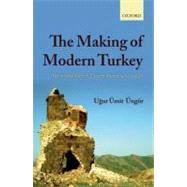
Note: Supplemental materials are not guaranteed with Rental or Used book purchases.
Purchase Benefits
Looking to rent a book? Rent The Making of Modern Turkey Nation and State in Eastern Anatolia, 1913-1950 [ISBN: 9780199603602] for the semester, quarter, and short term or search our site for other textbooks by Ungor, Ugur Umit. Renting a textbook can save you up to 90% from the cost of buying.
| Preface | p. vii |
| Acknowledgements | p. xvii |
| List of Illustrations | p. xix |
| List of Maps | p. xx |
| List of Abbreviations | p. xxi |
| Introduction | p. 1 |
| Nationalism and Population Politics in the Late Ottoman Empire | p. 8 |
| An introduction to Diyarbekir | p. 8 |
| The advent of nationalism | p. 25 |
| The discovery of society and population policies | p. 33 |
| Violence, victimization, and vengeance | p. 42 |
| Discussion | p. 51 |
| Genocide of Christians, 1915-16 | p. 55 |
| War and persecution | p. 55 |
| 'Burn, destroy, kill': the persecution becomes genocidal | p. 71 |
| Centre and periphery: widening and narrowing scopes of persecution | p. 86 |
| Discussion | p. 100 |
| Deportations of Kurds, 1916-34 | p. 107 |
| 1916: phase one | p. 108 |
| 1925: phase two | p. 122 |
| 1934: phase three | p. 148 |
| Discussion | p. 166 |
| Culture and Education in the Eastern Provinces | p. 170 |
| The Young Turk cultural revolution | p. 170 |
| The nation in the province: culture and education in Diyarbekir | p. 186 |
| The boarding school for Kurdish girls | p. 204 |
| Discussion | p. 212 |
| The Calm after the Storm: The Politics of Memory | p. 218 |
| Silencing the violence: the organization of oblivion | p. 218 |
| Damnatio memoriae: destruction and construction of memory | p. 224 |
| Memory politics in Diyarbekir | p. 232 |
| Toponymical changes | p. 240 |
| Discussion | p. 245 |
| Conclusion | p. 251 |
| Bibliography | p. 265 |
| Index | p. 297 |
| Table of Contents provided by Ingram. All Rights Reserved. |
The New copy of this book will include any supplemental materials advertised. Please check the title of the book to determine if it should include any access cards, study guides, lab manuals, CDs, etc.
The Used, Rental and eBook copies of this book are not guaranteed to include any supplemental materials. Typically, only the book itself is included. This is true even if the title states it includes any access cards, study guides, lab manuals, CDs, etc.